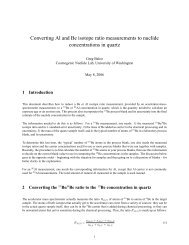Be exposure age calculator MATLAB function reference Version 2
Be exposure age calculator MATLAB function reference Version 2
Be exposure age calculator MATLAB function reference Version 2
Create successful ePaper yourself
Turn your PDF publications into a flip-book with our unique Google optimized e-Paper software.
logspace(log10(810000),7,200) gives 200 log-spaced points from 0.8 to 10 Myr. Note that 99% saturation<br />
occurs at 9.97 Myr for 10 <strong>Be</strong> and 4.69 Myr for 26 Al. This means that the calculation is not strictly accurate for<br />
near-saturated surfaces. Thus, this <strong>function</strong> is conservative about deciding whether or not an <strong>age</strong> can be calculated:<br />
measurements that are very close to saturation will probably be reported as saturated. If you are interested in a very<br />
precise evaluation of whether or not a particular measurement is saturated with respect to a particular scaling scheme,<br />
this code is not for you.<br />
2.2. Calculate cutoff rigidity Rc as a <strong>function</strong> of time<br />
We use the same magnetic field reconstruction for all the time-dependent scaling schemes; however, the different<br />
schemes use different methods for deriving the cutoff rigidity from the magnetic field parameters. From 0-7000 yr BP,<br />
the magnetic field is taken to be the spherical harmonic reconstruction of Korte and Constable. For 7000 - 800,000 BP,<br />
the field is taken to be a geocentric axial dipole with intensity given by Yang at al. (7000 - 11,500 BP) and SINT800<br />
(11,500 - 800,000 BP). Prior to 800,000 BP, the magnetic field is assumed to be a geocentric axial dipole with the<br />
aver<strong>age</strong> intensity of the SINT800 record.<br />
The main text of the paper gives additional details about the source of the magnetic field data and the derivatives<br />
thereof.<br />
For the De scaling scheme, for 0-7000 yr BP, cutoff rigidity is directly interpolated for the sample site from the global<br />
grids of cutoff rigidity values obtained by trajectory tracing at 500-year intervals (Lifton and others (in prep) describe<br />
this calculation in more detail) <strong>Be</strong>fore 7000 BP, the cutoff rigidity R C is calculated from the geographic latitude of the<br />
sample according to equation (19) of Desilets et al. (2003):<br />
R C =<br />
6∑<br />
i=0<br />
[e i + f i<br />
( M<br />
M 0<br />
)]<br />
θ (i) (5)<br />
where (M/M 0 ) is the ratio of the field intensity at the past time of interest to the present field intensity and θ is the<br />
geographic latitude of the sample. The constants e i and f i are as follows:<br />
i e i f i<br />
0 −4.3077x10 −3 1.4792x10 +1<br />
1 2.4352x10 −2 −6.6799x10 −2<br />
2 −4.6757x10 −3 3.5714x10 −3<br />
3 3.3287x10 −4 2.8005x10 −5<br />
4 −1.0993x10 −5 −2.3902x10 −5<br />
5 1.7037x10 −7 6.6179x10 −7<br />
6 −1.0043x10 −9 −5.2083x10 −9<br />
For the Du scaling scheme, for 0-7000 yr BP, cutoff rigidity is directly interpolated for the sample site from global<br />
grids of cutoff rigidity values that were obtained by applying equation (2) of Dunai (2001) to the horizontal field<br />
intensity and inclination of the Korte and Constable field model, again at 500-year intervals. We thank Nat Lifton for<br />
generating these grids. <strong>Be</strong>fore 7000 BP, the cutoff rigidity R C is calculated from the geographic latitude of the sample<br />
according to equation (1) of Dunai (2001):<br />
( ) M<br />
R C = 14.9 [cos(θ)] 4 (6)<br />
M 0<br />
For the Li scaling scheme, for 0-7000 yr BP, cutoff rigidity is directly interpolated for the sample site from the global<br />
grids of cutoff rigidity values obtained by trajectory tracing. <strong>Be</strong>fore 7000 BP, the cutoff rigidity R C is calculated from<br />
10



